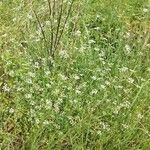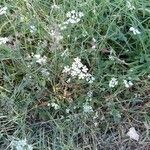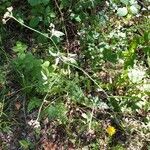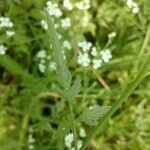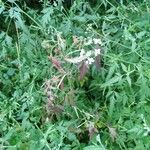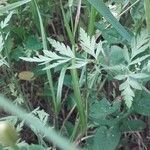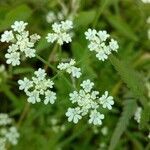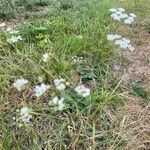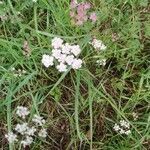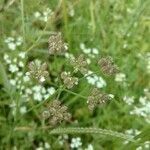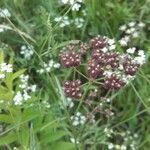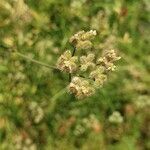Erect annual. Stems densely hairy above but glabrous or sparsely hairy near base, solid, striate, 20-60-(100) cm high, sometimes purple tinged; hairs deflexed. Basal lvs densely hairy above and below, 2-pinnate, petiolate; ultimate segments ovate to lanceolate, pinnatifid and serrate, 15-45 mm long, sessile or shortly petiolulate; stem lvs similar to basal, but 1-pinnate or pinnately 3-foliolate toward apex with less divided segments. Umbels 1-4-(5) cm diam., long-pedunculate, usually terminal; rays (2)-3-9, 5-20-(30) mm long; bracts 0-1, linear; bracteoles 5-6, linear. Fls few to numerous, white or tinged pink, c. 2 mm diam., irregular. Fr. ovoid, 3.5-4.5 mm long; all mericarps spinous; spines curved upward, thickened at tip.
Freely branched, taprooted annual to 1 m, the stem retrorsely, the lvs antrorsely rough-strigose or partly glabrous; lvs ovate or lance-ovate in outline, 2–3 times pinnate, or the upper only once pinnate, at least the lower pinnae generally evidently petiolulate, the ultimate segments rather small; peduncles terminal and lf-opposed, 3–16 cm, invol wanting, or of a single slender bract; rays 2–10, 0.5–2.5 cm; pedicels 1–4 mm; fr ovoid-oblong, 3–5 mm, covered with widely spreading, nearly straight, cylindric-subconic, slightly upcurved prickles approaching 1 mm; 2n=12. Native of Europe, now well established as a weed in s. U.S., n. to D.C., O., Ill., and Kans. June, July.
Sprawling, soft, annual herb, 0.03-0.50(-1.00) m high. Leaves finely divided, hairy, often tinged purple, leaflets toothed. Flowers few, in leaf-opposed umbels; peduncles ± as long as, or longer than leaves; involucre absent. Rays 2-4. Umbellules 3-6-flowered. Involucel of 4-6 bracteoles. Petals white, setose-hairy. Flowering time Aug.-Nov. Fruit burr-like with barbed prickles; both secondary and primary dorsal ribs of fruit pilose.
Sprawling, softly hairy annual, up to 0.4 m tall. Leaves finely divided, leaflets softly hairy, toothed. Umbels leaf-opposed. Flowers white to pinkish, outer petals larger. Fruit burr-like, with barbed prickles, mericarps isodiametric, homomorphic, vittae absent, rib oil ducts prominent.
Sprawling, soft annual to 40 cm. Leaves finely divided, leaflets pilose, toothed. Flowers few in simple, leaf-opposed umbels, white to pinkish, petals unequal. Fruit burr-like with barbed prickles, mericarps isodiametric, homomorphic, vittae absent, rib oil ducts prominent.
Fruit 3–5 mm. long, ovoid, densely covered with spreading, spiny glochidiate hairs, usually blackish-green when mature; sometimes 1, or rarely both, mericarps lacking spines and then covered with warty tubercles.
Inflorescence of terminal and lateral compound umbels; bracts 0 (1), rays 2–5 (-10), with appressed white bristles; bracteoles linear, acute, almost equalling the pedicels of the few-flowered partial umbels.
Leaves very variable, from 2-pinnate to 3-foliate; margins coarsely serrate to subentire, with numerous appressed white bristly hairs on the lamina, rhachis and petiole.
Calyx teeth minute; stylopodium depressed; styles very variable in length, in African material usually c. twice as long as the stylopodium.
Stem terete, glabrous, with fine grooves, sometimes purplish-tinged especially towards the base, little branched in African specimens.
Seed curved in section, with the ends facing towards the commissure, but not recurved.
Root system a well-developed primary taproot, with limited secondary branches.
Petals white, the outer ones sometimes slightly radiate.
An erect annual herb up to 1 m., usually much smaller.
Vittae 5, large and well developed.
A wiry herb
A herb.
